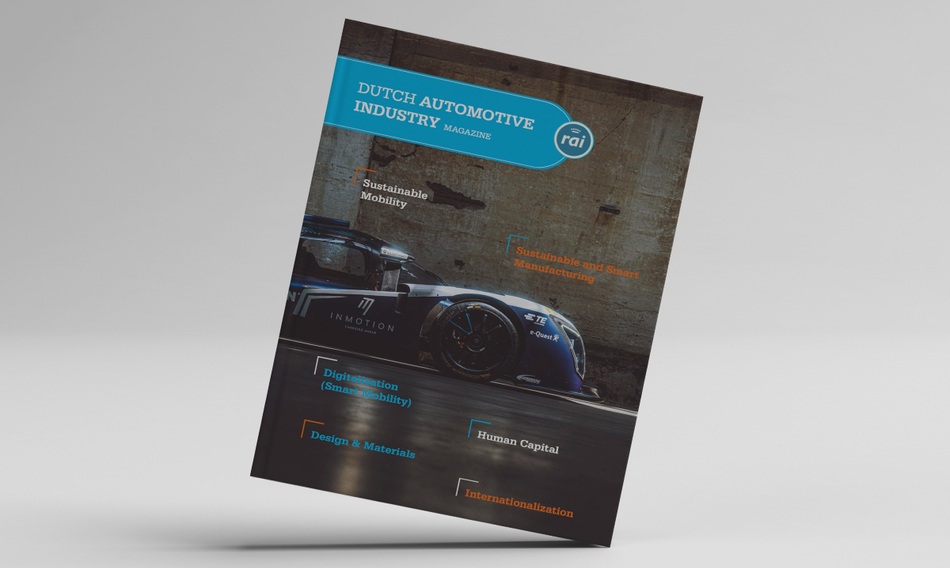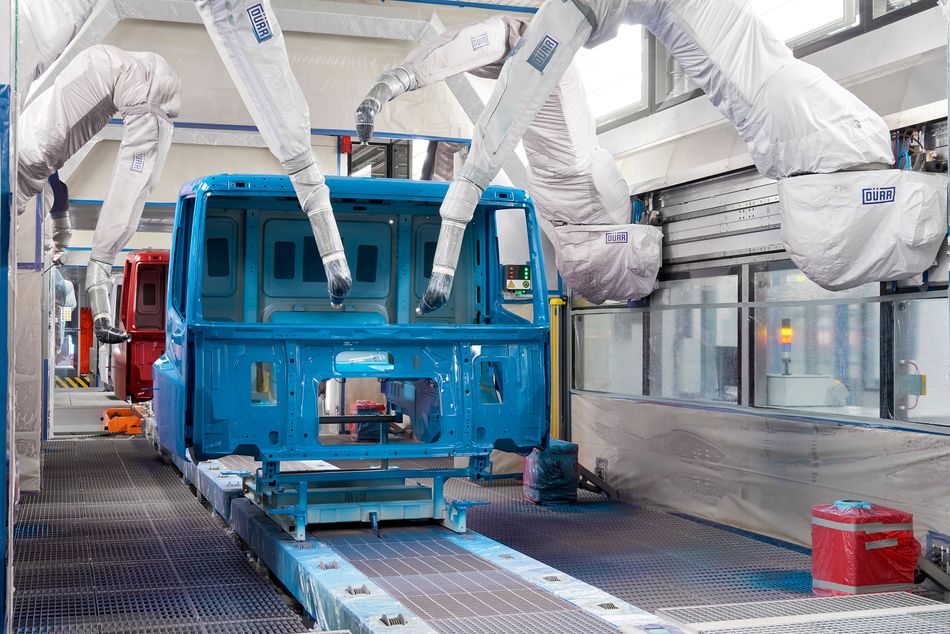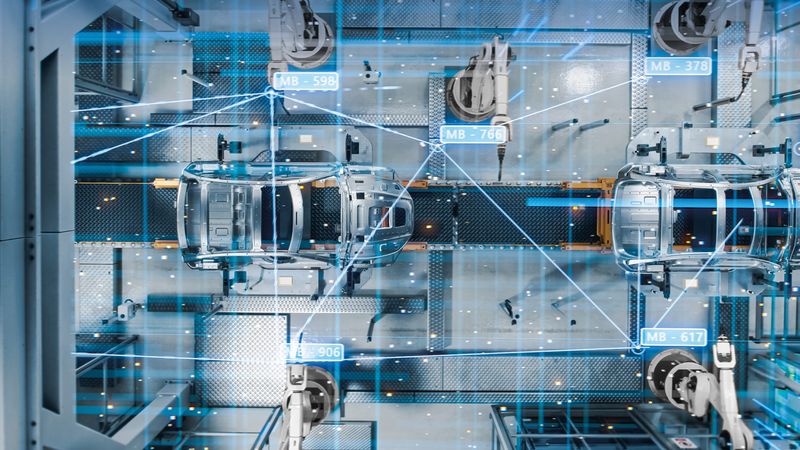Design and Materials in the Dutch Automotive Industry: Innovations and Future Directions
As sustainability requirements, government policies, and consumer demand continue to put pressure on the automotive market, the Dutch automotive industry is finding effective ways of integrating cutting-edge materials and sustainable design practices to redefine the future of mobility.
We are pleased to introduce the latest edition of the RAI Automotive Industry NL report, which provides an in-depth exploration of the Dutch automotive sector's transformative trajectory. This sector, situated at the nexus of rapid technological advancements and pressing global challenges, exemplifies a model of innovation, sustainability, and resilience in a highly competitive international landscape.
DOWNLOAD THE FULL INDUSTRY REPORT
This issue covers core themes: smart and green mobility, sustainable manufacturing, human capital development, design and materials, and internationalization. Each of these pillars underscores the industry's commitment to integrating advanced technologies into mobility solutions, driving the future of transportation with a focus on efficiency, safety, and sustainability.
Below you can read an excerpt of one of the featured articles. Or download the full report for free.

As sustainability requirements, government policies, and consumer demand continue to put pressure on the automotive market, the Dutch automotive industry is finding effective ways of integrating cutting-edge materials and sustainable design practices to redefine the future of mobility.
Central to this transformation is the strategic implementation of lightweight composites, advanced manufacturing technologies, steel recycling and reuse, and a robust commitment to circular economy principles This forward-thinking approach not only enhances vehicle performance but also significantly reduces environmental impact, positioning The Netherlands as a leader in sustainable automotive innovation. With RAI Automotive Industry NL at the forefront of progress, the Dutch automotive industry is charting a course through challenging but promising terrain, establishing new standards for performance, environmental responsibility, and technological leadership.
Leading the Charge in Sustainable Automotive Design
The automotive industry is at a crossroads, balancing the demands for sustainability with the need for advanced performance. In The Netherlands, this balance is being managed through innovative design and the use of new materials. In a conversation with Freek de Bruijn, Program Manager Design and Materials at RAI Automotive Industry NL, he says, “Our goal is to emit as little CO2 as possible by 2030,” highlighting the ambitious targets set by the industry. This commitment to reducing emissions is driving a focus on zero-emission vehicles, hydrogen-powered technologies, and smart innovations, all of which contribute to a greener future.
However, little has been done in terms of policies for materials. “We do have the national circular economy program,” says de Bruijn, “and there is a little bit mentioned about lightweight and what that means for the automotive industry and mobility, in general. But we don’t have a clear policy document for materials like we have with batteries or hydrogen.” Such a limitation means that a lot of companies, including RAI members, are looking for innovation possibilities and subsidies to stimulate their innovation with materials.
DOWNLOAD THE FULL INDUSTRY REPORT
Towards a Circular Economy
The traditional “take-make-dispose” economic model is undergoing a transformation. In The Netherlands, the government is pushing for a complete transition to a circular economy by 2050. This innovative approach aims to keep resources in use for longer by prioritizing reuse and remanufacturing over waste. “Imagine a system where what we currently discard becomes the fuel for new products,” says De Bruijn. “That’s the essence of the circular economy. By repairing, refurbishing, and recycling existing materials, we can significantly reduce our dependence on virgin raw materials extracted from the earth.” This vision is reflected in the National Circular Economy Programme (NCPE), which outlines a roadmap for achieving a dramatic reduction in virgin material use. The ambitious goal is to slash virgin material consumption by 50% by 2030, paving the way for a complete phase-out by 2050.
This theme is already in play and is, therefore, new to the automotive industry and supply chain in The Netherlands. Most SMEs are struggling to keep up, making it a serious challenge. Therefore, design must be optimized, minimizing resistances to meet circularity targets. The circular economy offers a win-win solution. By conserving resources, we lessen our environmental impact. Additionally, it fosters innovation in product design and waste management, creating new economic opportunities.
RAI Automotive Industry NL supports the Circular Economy R-ladder methodology, which emphasizes minimizing raw material use through a hierarchical approach. The R-ladder demonstrates the degree of circularity: The higher up the R-ladder strategy is, the more circular it is, and the lower the raw material used is. The R-ladder consists of six steps representing different circularity strategies:
R1 - Refuse and rethink: Abandon products or use them more intensively
R2 - Reduce: Manufacture efficiently or optimize usage
R3 - Re-use: Utilize second-hand products
R4 - Repair, refurbish, remanufacture, repurpose: Repair or reuse parts
R5 - Recycle: Process and reuse materials
R6 - Recover: Recover energy from materials
RAI Automotive Industry NL is committed to working through this methodology in cooperation with its members. By adopting the R-ladder approach, the industry aims to significantly reduce waste and enhance the sustainability of automotive materials, ensuring that resources are used as efficiently as possible throughout the product life cycle. This commitment not only supports environmental goals but also aligns with broader efforts to create a sustainable and resilient automotive sector.
Evolution of Design and Materials Innovation
Over the past decade, the Dutch automotive industry has seen remarkable advancements in design and materials. The emphasis on lightweight materials has been particularly significant. “As battery technology advances, vehicle weight is increasing. To counter this, we must prioritize lightweight vehicle construction,” De Bruijn emphasizes. This need has led to a surge in the use of lightweight materials like for instance, carbon fiber, which offers superior strength-to-weight ratios.
A key example of this focus on lightweight materials is RAI Automotive Industry NL’s collaboration with the European Lightweight Association (ELA). This partnership aims to leverage the combined strengths of European regions to advance lightweighting technology. By working with ELA, RAI Automotive Industry NL broadens access to customers, technologies, and best practices, enhancing the competitive position of its member businesses.
The industry’s drive to reduce CO2 emissions has brought attention to the environmental impact of vehicle weight. Lighter vehicles require less energy, thereby reducing overall emissions. The integration of lightweight materials has extended beyond the automotive sector to aerospace and urban infrastructure, showcasing the versatility and impact of these innovations. Additionally, ELA’s efforts support the European Green Deal, highlighting the role of lightweight technology in climate protection and ensuring a brighter future for coming generations.

Simultaneously, the Dutch and European automotive sectors have been pioneers in sustainable manufacturing practices, with a significant focus on steel recycling and reuse. With steel In The Netherlands, recycling rates for steel are among the highest in the world, thanks to robust systems and technologies for collecting and processing end-of-life vehicles. This commitment to recycling is mirrored across Europe, driven by stringent regulations and a collective effort to reduce the environmental footprint of vehicle production. Sustainable manufacturing in the automotive industry not only includes recycling but also the use of renewable energy sources, efficient production processes, and the development of circular economy principles. These initiatives ensure that materials are reused and waste is minimized, contributing to a more sustainable future for the automotive sector and aligning with broader European sustainability goals.
In 2023, The Netherlands was able to recycle 98.7% in terms of the weight of each vehicle, comfortably meeting the European rules for at least 95% car recycling. The percentage achieved in 2023 consists of 88.1% reuse and recycling and 10.6% energy recovery or other useful applications. The increase in the reuse and recycling percentage is because the proportion of reuse at car dismantling companies has increased.
Promising Materials and Composites
The quest for enhanced performance and efficiency has led to the exploration of various materials and composites. Thermoplastics and thermosets are at the forefront of this exploration. “Thermoplastic materials are quite easy to recycle, whereas thermosets, while stronger, are more challenging to recycle,” De Bruijn notes. This distinction is crucial as the industry seeks materials that not only perform well but are also sustainable.
Recycling thermoset plastics is challenging compared to thermoplastics due to their permanently linked molecular structure, which doesn’t melt when heated, making them difficult to reshape. However, scientists are researching new recycling methods, including chemical treatments that break down the cross-linked structure for reprocessing. While large-scale recycling of thermosets isn’t yet commonplace, these developments offer hope for a more sustainable future for these materials.
Another leading sector in this space is the composite industry, given that composite materials are lightweight and can be used extensively in a wide range of automotive parts. The trends in areas like composite materials show that there have been many innovations and advancements, with the most important development being the demand for lightweight solutions.
A significant development in this area is RAI Automotive Industry NL’s partnership with CompositesNL, which focuses on advancing the use of composite materials within the automotive industry. By working together, RAI Automotive Industry NL and CompositesNL aim to enhance the performance and sustainability of composite materials, ensuring they meet the rigorous demands of modern vehicles while promoting recyclability and environmental responsibility.
Smart Design Technologies: 3D Printing and Beyond
In addition to developments in materials, advanced manufacturing technologies, such as 3D printing, are revolutionizing the automotive industry. “3D printing offers design freedom, cheaper manufacturing, and reduced energy use,” De Bruijn points out. This technology allows for layer-by-layer manufacturing, creating complex parts with minimal material waste. The ability to produce lightweight, organic-looking parts enhances both performance and efficiency. This not only applies to plastics but also to metals. Metal 3D printing leverages the metals’ strength properties, allowing for more gaps in the structure without compromising the structure’s integrity and strength.
Hybrid combinations of materials, such as steel and plastics, are also gaining traction. These combinations offer the best of both worlds, providing strength and durability while reducing weight. The challenge lies in ensuring these hybrid materials are easily disposable and recyclable, aligning with the industry’s sustainability goals.
RAI Automotive Industry NL’s Role in Industry Support
RAI Automotive Industry NL plays a crucial role in supporting the Dutch automotive industry through policy advocacy, knowledge exchange, and international collaboration. “Our goal is to connect parties so that they know who is doing what, which is a productive solution,” De Bruijn explains. By facilitating connections between manufacturers, suppliers, and other stakeholders, RAI Automotive Industry NL helps foster innovation and collaboration.
One of the association’s key initiatives is learning from international counterparts. Countries like Germany, Austria, Switzerland, and Sweden have implemented successful policies and funding programs for materials innovation. By studying these models, RAI Automotive Industry NL, together with ELA, aims to replicate and adapt successful strategies for the Dutch context. This approach ensures that Dutch companies have the support they need to innovate and remain competitive.
On the international scale, RAI Automotive Industry NL works closely together with CLEPA, the leading voice for European automotive suppliers, representing 3,000 companies across 19 countries. As a key industry liaison with governments and global bodies, CLEPA advocates for its members’ interests, including RAI Automotive Industry NL.
DOWNLOAD THE FULL INDUSTRY REPORT
Notable Collaborations and Projects
Collaborations between Dutch automotive companies and research institutions are pivotal in advancing design and materials innovation. One notable example is the Light Vehicle 2025 project, where RAI Automotive Industry NL worked with their member Sekisui Europe, amongst others, to develop innovative automotive components. The project focused on reducing the life cycle analysis (LCA) of various parts, achieving significant improvements in sustainability.
“We reduced the number of parts and amount of material and looked at different manufacturing technologies,” De Bruijn explains. The success of the Light Vehicle 2025 project led to the submission of the CYPRESS project, which aims to further explore circularity and sustainable manufacturing.
One of the RAI members that stands out in the design and materials space is Pontis Engineering. They specialize in advanced composite materials and innovative design solutions for the automotive industry. Their primary focus is on developing lightweight, high-performance components that enhance vehicle efficiency and sustainability. A notable example of their work is the development of carbon fiber-reinforced polymer (CFRP) structures for electric vehicles (EVs). These materials significantly reduce the overall weight of the vehicle, thereby improving battery range and reducing energy consumption.
Recently, Pontis Engineering collaborated with a leading EV manufacturer to create a fully composite chassis. This chassis not only meets stringent safety standards but also offers superior performance characteristics compared to traditional materials. The use of CFRP allowed for a 30% weight reduction, demonstrating the potential of advanced materials in revolutionizing automotive design.
Pontis Engineering sees the Dutch automotive industry as a dynamic and rapidly evolving sector. The industry is heavily investing in research and development to stay ahead in the global market, and Dutch companies are known for their innovation and high-quality engineering, positioning them well to tackle the challenges of sustainability and digitalization.
Looking ahead, Pontis Engineering predicts significant advancements in the use of composite materials and smart design techniques. The push towards electric and autonomous vehicles will drive demand for lightweight, durable, and versatile materials. They expect to see more integration of different materials with different properties creating smart hybrid structures meeting different requirements in an efficient way, enhancing vehicle performance and safety.
Challenges in Adopting Sustainable Materials
Despite the significant advancements, the Dutch automotive industry faces unique challenges in adopting sustainable materials. “Raw materials are scarce, and it takes a lot of energy to extract them,” De Bruijn highlights. This scarcity underscores the importance of recycling and reusing materials to mitigate environmental impact and reduce dependency on finite resources. For example, prices for copper are reaching all-time records almost daily, and if the way copper is harvested is not changed, known reserves could run out in as little as 37 years. Research is being conducted on replacing copper with silver and carbon in PCBs to address this issue.
Projects focused on retracting materials from existing vehicles and PCBs are crucial in addressing this challenge, aiming to create a circular economy where materials are continuously repurposed. There are research projects using AI to identify every part of a depreciated vehicle: what materials are present, their locations, and the types of metals involved. This AI system also assesses the degree of recyclability for each metal and provides feedback on how to efficiently disassemble components, suggesting improvements like using snap fits instead of screws. Currently, there are many different rare metals in PCBs. Existing recycling methods are not designed to recover these substances effectively, leading to losses. The solution lies in scanning and designing methods to locate and extract these metals. Research shows that AI, combined with cobots, can identify and remove these materials from printed boards, a step towards developing a passport for PCBs similar to battery passports.
One of the critical strategies being explored is remanufacturing, which involves dismantling and rebuilding engines and other components to extend their lifespan and reduce waste. “Remanufacturing allows us to rebuild certain parts from scratch, minimizing the need for new raw materials,” De Bruijn explains. However, this process is still in its experimental phase and not yet profitable, posing a challenge for widespread adoption. The industry is working to refine these techniques to make them more economically viable and scalable.
Another challenge is the integration of lightweight materials such as carbon fiber and composites, which are essential for reducing vehicle weight and improving efficiency. While these materials offer significant performance benefits, their production and recycling processes can be complex and costly. The industry is investing in research to develop more efficient manufacturing techniques and recycling methods for these advanced materials.
In addition to technological advancements, regulatory frameworks must evolve to support the adoption of sustainable materials. “Legislation and regulation need to catch up with technological developments,” De Bruijn asserts. This includes creating policies that incentivize the use of recycled materials and support the development of infrastructure for collecting and processing end-of-life vehicles and components. Collaboration and policy support are critical in overcoming these challenges. RAI Automotive Industry NL plays a central role in connecting industry stakeholders with government bodies and research institutions to facilitate innovation and share best practices.
Looking ahead, the Dutch automotive industry is committed to overcoming these challenges through continuous innovation and collaboration. By integrating sustainable materials, advancing manufacturing technologies, and developing supportive regulatory frameworks, the industry aims to lead the way in creating a more sustainable and efficient future for mobility.
A Sustainable Future for Dutch Automotive Innovation
The Dutch automotive industry is poised for further advancements in sustainability and materials innovation in the near future. Circularity will remain a central focus, with efforts to redesign, remanufacture, and recycle automotive components gaining momentum. “It’s important to keep the raw materials within Europe and ensure they are reused effectively,” De Bruijn reiterates.
The integration of lightweight materials will continue to grow, driven by the need for efficient, high-performance vehicles. Composite materials, particularly carbon fiber, will play a key role in this evolution. The industry’s commitment to reducing emissions and enhancing sustainability will drive ongoing research and development.
The Dutch automotive industry is navigating a transformative period driven by the need for sustainable practices and innovative materials. With the support of RAI Automotive Industry NL and its members, the industry is addressing the challenges of reducing emissions, resource dependency, and material scarcity. By embracing new materials, smart technologies, and circular economy principles, the Dutch automotive sector is set to lead the way in sustainable automotive innovation.
Learn more about the work of the RAI Automotive Industry NL's members by downloading the full report below.
DOWNLOAD THE FULL INDUSTRY REPORT

